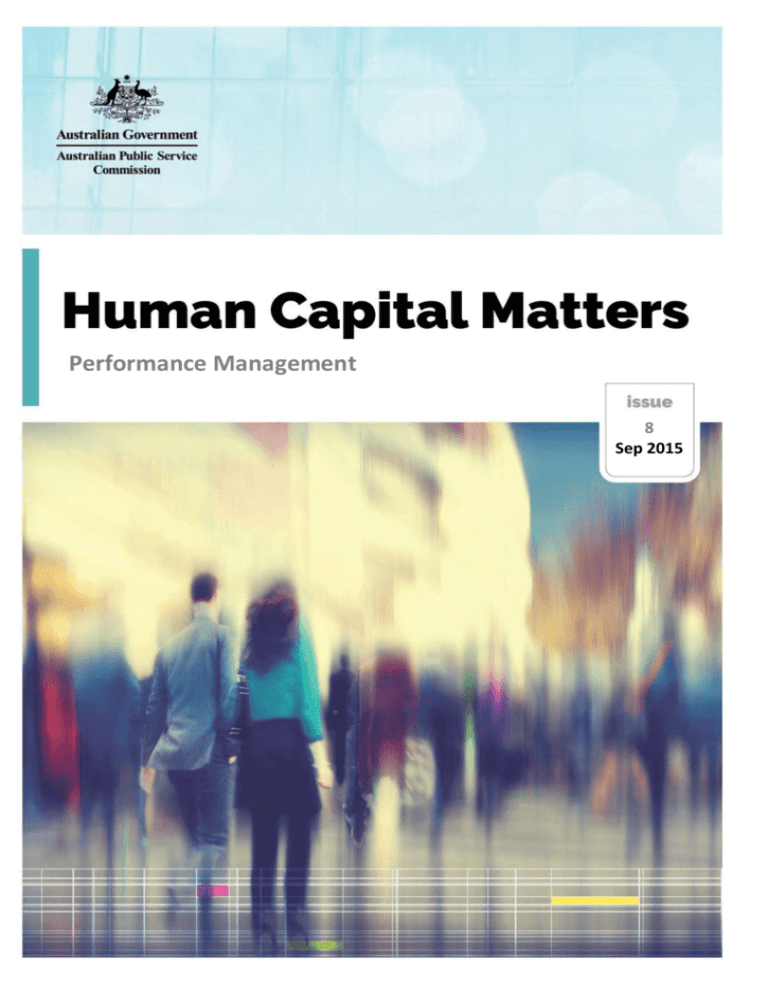Proposed Digest of Journal Articles for Public SES
advertisement

Performance Management 8 Sep 2015 APS Human Capital Matters: Performance Management September, 2015, Issue 8 Editor’s Note to Readers Welcome to the eighth edition of Human Capital Matters (HCM) for 2015—the digest for leaders and practitioners with an interest in human capital and organisational capability. Human Capital Matters seeks to provide APS leaders and practitioners with easy access to the issues of contemporary importance in public and private sector human capital and organisational capability. It has been designed to provide interested readers with a monthly guide to the national and international ideas that are shaping human capital thinking and practice. The inclusion of articles is aimed at stimulating creative and innovative thinking and does not in any way imply that the Australian Public Service Commission endorses service providers or policies. Thank you to those who took the time to provide feedback on earlier editions of Human Capital Matters. Comments, suggestions or questions regarding this publication are always welcome and should be addressed to: humancapitalmatters@apsc.gov.au. Readers can also subscribe to the mailing list through this email address. This edition focuses on performance management. The ninth edition of HCM in 2014 cited an article in which it was suggested that most performance management systems had become exercises in compliance. As a consequence, the article suggested, performance management systems had become counterproductive at a time when organisations needed to be more innovative generally and with regard to performance management more specifically; there was an unintended consequence in that performance management and its attendant requisites of accountability and results-oriented performance appeared to drive out innovation among employees. In June last year the Canadian Government Executive , a journal for public sector executives in Canada, published an article in which the author described the performance management arrangements in most western public sector environments: performance information feeds into an incentive system of rewards and sanctions for employees who serve the public. Like most management strategies, the author suggested, performance management had had its day. Whilst there was evidence to suggest some general improvement in performance, there had also been unintended and less desirable consequences. Over time performance management became less about incentivising individual employees and more about compliance. Associated with this has been the ‘concentration of control’ at the apex of the organisational structure. APS employees might recognise this as the escalation of authority for decision-making. The author suggested that compliance and elevated decision-making possibly obstructs the agility of organisations at a time when new ideas and processes are much needed. So then, what is the status of performance management for forward thinking organisations including the APS? This 2015 edition on performance management reviews some of the available material on the current status of performance management systems. 2 The articles are: The first article from Pricewaterhouse Coopers Australia (PwC) in 2015 reported that few Australian organisations are abandoning traditional approaches to performance management. Most are ‘tweaking’ existing frameworks. The more radical changes include: removing performance ratings altogether, removing the link to reward and abandoning the annual review cycle. The disadvantage of the traditional approaches, as reported by more than three-quarters of surveyed companies, was the emphasis on process at the expense of the quality of discussion and outcomes. More than half of the surveyed companies in Australia (67%) reported performance management was seen as a compliance exercise. Almost all of those surveyed (96%) had begun to change their performance management framework or were planning significant changes over the coming year in their performance management systems. The second article is an abstract from a report in the Australian Financial Review in which it is reported that a number of large organisations—including National Australia Bank, Deloitte, Accenture and SEEK—have abandoned performance reviews, opting for more regular feedback sessions. The third article is another news item on an earlier PwC report from 2014 in which the performance management systems in Australian businesses were found to be ‘outdated’ and as having no beneficial effect on productivity. The fourth article is the 2004 ANAO Audit report on performance management in the APS. This paper is included to demonstrate the perennial nature of the concerns about the effectiveness of performance management systems. It identified the key outcomes required of performance management in the APS and used the framework proposed by the Management Advisory Committee (MAC) in 2001 to assess the effectiveness of existing systems in 69 APS agencies in which more than 100 APS staff were employed. Lack of alignment with organisational objectives, lack of credibility for staff and lack of integration in the form of connections with rewards and learning and development needs were seen in 2004 to be the weaknesses of existing APS performance management systems. In the final article, ANAO has once again tackled the issue of performance management systems, this time in the complex environment of DHS Smart Centres. Employee performance management metrics used by DHS in 2014-15 were considered by ANAO to be process-driven and of limited use in assessing the success or otherwise of the Smart Centre concept. ANAO concluded that DHS needed to review its metrics on things such as First Call Resolution and handling times so as to reflect the strategic intent of the department. It would appear that performance management systems in the APS have a long and vexatious history. The burdensome and questionable value of employee performance management systems is also evident in organisations outside the APS. Innovation within existing performance management systems, at the very least and without considering what can be done outside existing systems, would appear to be warranted. 3 Pricewaterhouse Coopers (2015) Performance management: Change is on the way but will it be enough? Performance Management effectiveness in the ASX 150. March PwC conducted a survey of 27 ASX150 companies in 2015. The survey, originally developed by PwC for use in the UK in 2014, was augmented by one-on-one interviews with eight company respondents and surveys of 220 employees. Participants included the National Australia Bank, Telstra, Caltex, and Lend Lease. The findings, in summary, were: Performance management needed to be improved rather than dumped, according to surveyed companies Most companies agreed that performance management systems add value to the delivery of business objectives. The clear majority say that discontinuing performance management would worsen business performance (70%) and reduce the organisation’s ability to engage and manage high and low performers (80%) Employees also agree performance management systems are effective though nearly half (42%) noted they would not feel any impact if the system were discontinued. Others noted there would be some impact on their engagement and motivation (35%) Companies reported that they are mostly satisfied with how well their performance management system achieves their key objectives (e.g., development planning, managing accountability, identifying and managing underperformance, engaging and motivating employees). Many (80%) identified that the execution of their performance management system could be improved Obstacles to highly effective performance management systems were seen to be too much process at the expense of quality discussion about performance, performance management as a compliance exercise and, insufficient leadership capability. More than 60% of respondents indicated that line managers didn’t prioritise performance management conversations and feedback or lacked the willingness or ability to objectively assess and differentiate performance As a result of their findings, PwC identified five potential areas for improvement in performance management systems. The first recommendation was: Innovate. PwC included five examples of innovations outside existing systems. Each example was described noting possible uses and risks (see the article, p.15 for more details): o Remove performance ratings and allow the performance discussion to become the focus o Decouple pay and performance or o Make the links between pay and performance more immediate, rather than an annual event o Decouple the coach and assessor roles to emphasise performance improvement rather than assessment o Abandon the annual review cycle Innovations within existing systems were incorporated into the following four areas: 4 Manage what matters most. Be clear about the most important purpose of the performance management system and avoid potentially conflicting objectives such as incentivising versus managing talent Over-service the executive levels when setting and drafting goals. Dissect top level strategy into actionable measures; foster business ownership whilst acknowledging that HR owns and supports the system; structure collaboration; review goals from different perspectives or lenses; publish executives’ goals; provide a consistent framework to cascade goals (e.g., balanced scorecard); and, encourage staff buy-in Drive more effective conversations. Development of line manager capability for coaching was rated by half of the respondents as the most important improvement they would make to the performance management system Go digital. It is common practice to deliver feedback ‘in the moment’ among most successful performance coaches. Most would consider it unthinkable to deliver constructive feedback at the end of a season. Providing timely feedback is important in the acquisition of any new skill and many of the surveyed companies were investing in or employing technology to do this (e.g., Yammer) in a structured, relevant and constructive way Another recommendation for change within existing performance management systems was to separate developmental and performance discussions e.g., keeping developmental discussion to the mid-year review (or more frequently) and focussing on performance in the final or annual discussion. Return to list of articles Australian Financial Review, For employers, ticking the box can’t get no staff satisfaction, 12 August 2015, p.11 The Australian Financial Review, reporting in August 2015 on PwC advice in March 2014, reported that several major companies—National Australia Bank, Deloitte, Accenture and SEEK—had abandoned annual performance reviews, opting for smaller more frequent feedback sessions. Return to list of articles Australian Financial Review, Businesses should boycott performance reviews, 5 March, 2014 Reporting initially on an interview with PwC managing director, Jon Williams, the Australian Financial Review (AFR) chose the headline ‘Businesses should boycott performance reviews’. Williams was quoted as saying that performance management systems in Australia were ‘outdated’ and ‘chew(ed) up time’ without improving productivity. It was also suggested that there was no relationship between performance management systems and engagement. The introduction of new bullying laws in January 2014 was seen as one catalyst for companies to review their performance management practices. Managers now needed to exercise clear and focussed communication with employees about performance or risk the perception of harassment. In the same article a Deloitte’s spokesperson—David Brown—spoke about businesses moving away from the ‘rank and yank’ model of performance ratings towards a coaching system which identified areas for employee development. This had been heralded in the USA with companies such as Microsoft and General Electric dropping the competitive nature of performance reviews so that 5 employees previously ranked at the lower end of the bell curve might still contribute positively to the organisation. Australian Human Resources Institute (AHRI) research was also reported. AHRI findings provided a similar perspective to the 2015 PwC findings. It was noted that while only 3% of surveyed HRM employees believed their performance management systems were very effective, only 34% believed they were totally ineffective. This adds weight to the idea that performance managements systems might be improved rather than abandoned. Curtin University School of Management spokesperson, Jane Coffey, also agreed many performance management systems were archaic. Performance management systems, it was suggested, should be more about investment in human capital. The unique nature of the business, the type of skills required and ensuring pertinent skills were sustained were all seen to be critical considerations in organisational performance systems. Other expert sources, Adelaide-based Stillwell Consulting and the Fair Work Ombudsman, were also reported as having identified that the performance management system required an overhaul. Regular or immediate feedback about task critical performance and adopting a more serious approach to providing feedback were seen as two improvements that could be made easily. Return to list of articles The Auditor-General Audit Report No.6 2004-05 Performance Audit Performance Management in the Australian Public Service, Commonwealth of Australia, Canberra, 2004 In its 2004 audit of APS agencies’ performance management systems, ANAO identified the following: Agencies were responsible for devising their own approach to performance management and any payments associated with performance assessments The application of better practice principles were varied and some agencies could have improved their systems to show consistency with the strategic framework set out in the MAC There were three critical success factors for performance managements systems: alignment, credibility and integration Concentrating on the third finding, in its summary the ANAO found that alignment of agency specific systems with agency level goals and priorities was variable. Most were driven by industrial relations processes rather than business needs and outcomes sought by the government. Agencies were reported as having made little attempt to assess the impact of their performance management systems on their organisation. In 2004, performance management was not yet regarded as an effective contributor to sound business outcomes in the APS. The credibility of performance management was seen to be lacking. A substantial gap was identified by surveyed employees between performance management rhetoric and reality. Among other things, employees perceived that there was a lack of clarity about what constituted good performance, that real incentives were lacking and that there was a disconnect between the application of performance management systems and recognition and reward mechanisms for staff. It was noted that 86% of bonuses in 2002-03 went to SES and EL staff adding weight to employee perceptions about lack of credibility and bias/inequity in the distribution of rewards. 6 In 2004 agencies were seen to be making progress in terms of integration of performance systems with corporate management structures and in providing clear links for staff between work and organisational goals. However, it was reported that significant improvements could be made in recognising and rewarding those who manage staff effectively and in identifying and assisting those who do not. Improvement in identifying learning and development needs in staff was also deemed as necessary. Return to list of articles The Auditor-General Audit Report No.37 2014-15 Performance Audit Management of Smart Centres’ Centrelink Telephone Services, Commonwealth of Australia, Canberra, 2015 ANAO reported in 2015 that DHS had commenced a review of Smart Centres’ performance measurement and reporting. The review will consider changes that reflect the objectives of the Centres and the implementation of the Skills Pyramid. It is anticipated that separate data may be available for the ‘general’, ‘assisted’ and ‘intensive’ layers of the pyramid. In the future, these separate data sets are expected to allow the department to identify appropriate performance expectations for each layer which will in turn, and as part of wider performance monitoring and reporting, position the department to respond and make appropriate adjustments to service delivery arrangements, neatly tying in individual performance with organisational objectives. A point made in this report is that quantifiable key performance indicators, such as average speed of answer, is easily accessible for stakeholders such as Parliament but does not provide a complete picture of performance. DHS responded to the ANAO recommendation to review key performance indicators by noting it agreed with the recommendation and that an additional 1000 staff at a cost of over $100 million every year would be required to achieve a reduced target of average time to answer. The indirect message in the DHS response is that performance—at both the individual and the organisational levels— is related to available resources; individual performance can sometimes be constrained by variables outside the control of the employee and traditional, quantifiable metrics may not reflect this. 7









